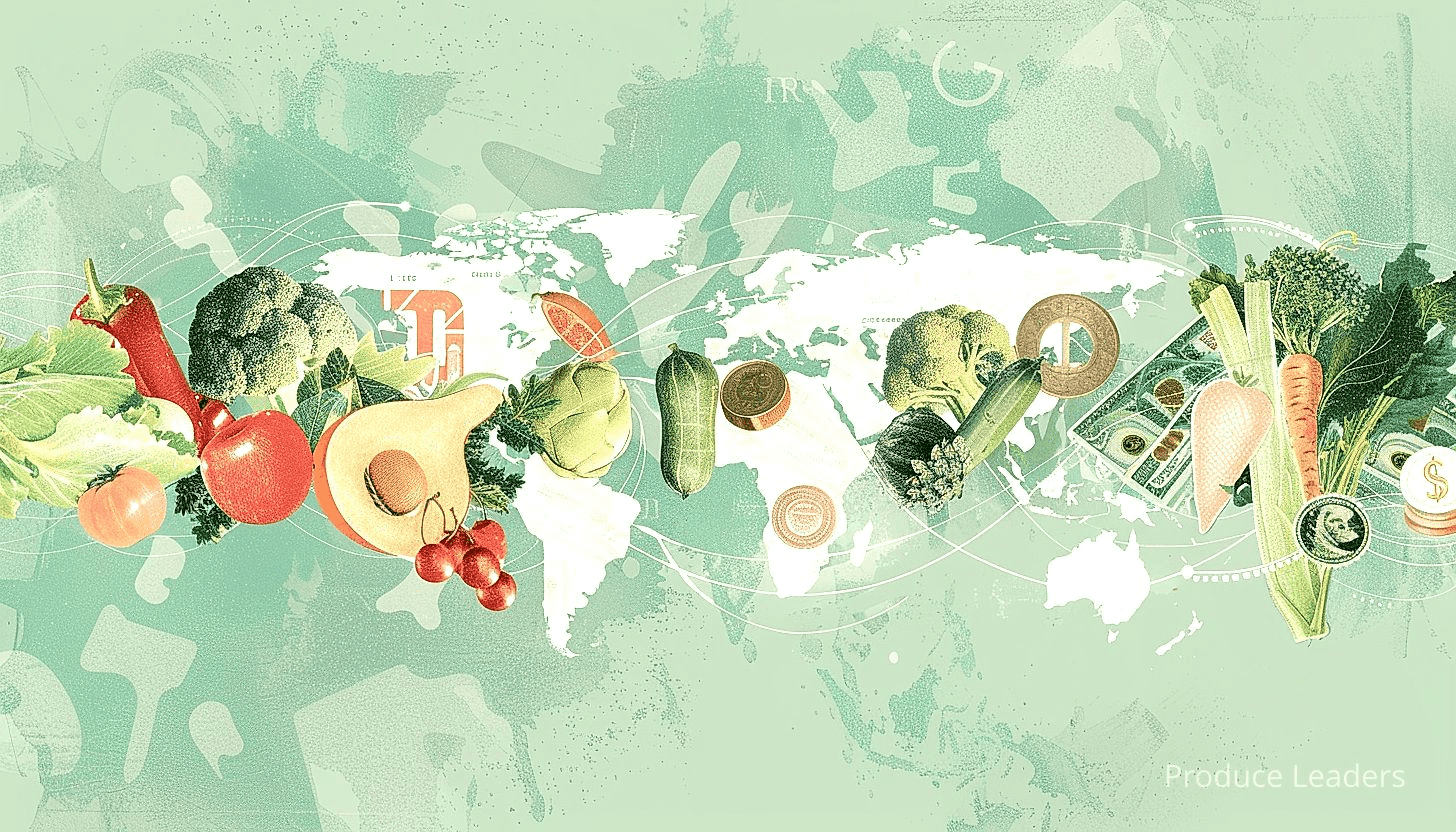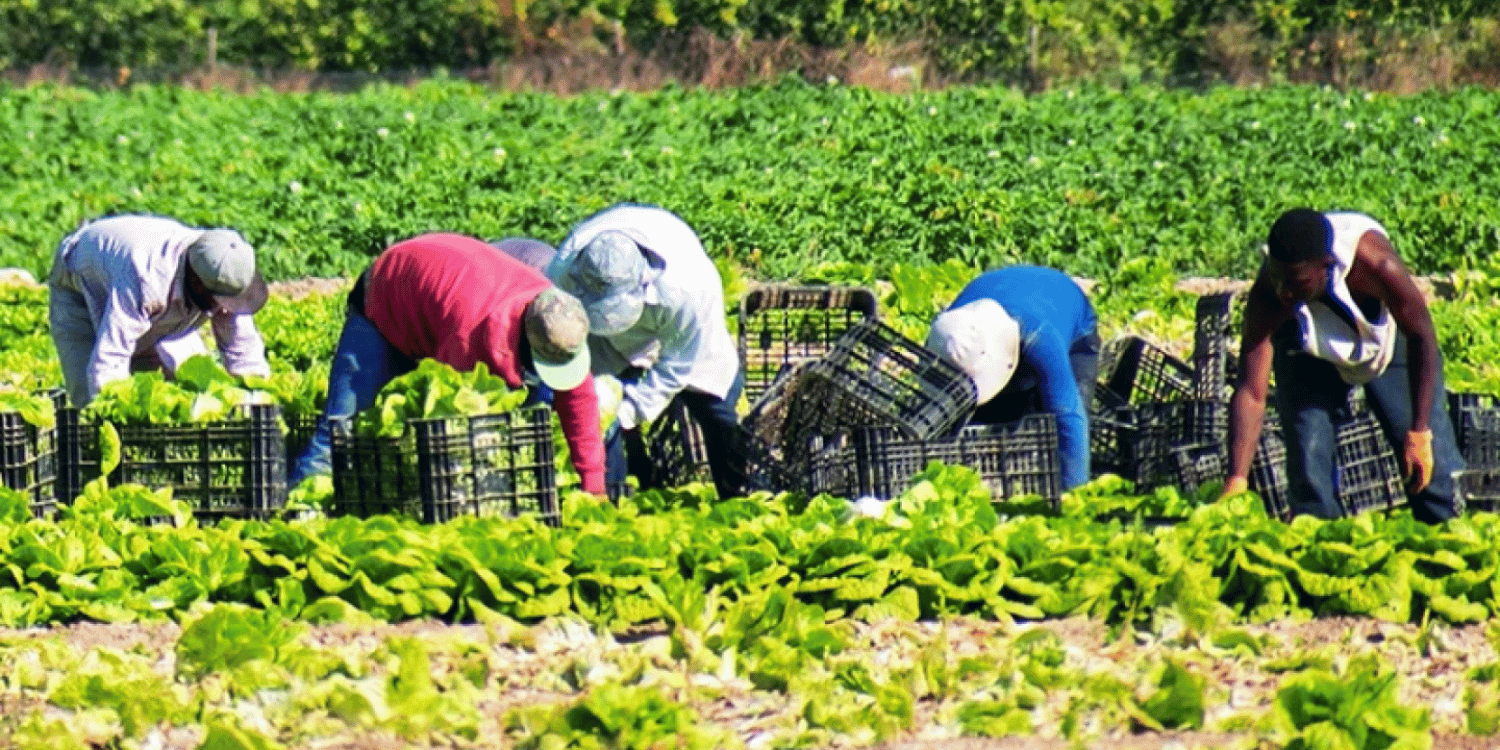Understanding the dynamics of international trade can be complex.
One critical yet often overlooked aspect is how movement in currency values can create far-reaching effects.
The produce sector is not immune to these monetary adjustments.
This significantly influences both importers and exporters of agricultural goods.
We will dig in into this intricate relationship, shedding light on its implications across the globe.
It’s crucial to arm ourselves with this knowledge to comprehend the market variations we often perceive.
- Currency fluctuations affect export competitiveness in produce trade.
- Such changes can shift trade balances significantly.
- Fluctuating currency values also impact import costs.
- Currency changes influence crop investment decisions.
- Volatility in currency markets leads to price uncertainty in produce trade.
While these key takeaways offer valuable insight into the impact of currency fluctuations on produce trade, there are other important areas we will explore in the following sections.
Our coverage extends to cases in past trade scenarios that have seen significant shifts due to currency changes, providing practical understanding of these impacts.
We will also examine the strategies that businesses can employ to mitigate risks associated with currency fluctuation and remain competitive in the ever-dynamic produce trade landscape.
Indeed, your understanding of how this critical cog in the economic machine works and its effects on everyday life and business will be immensely broadened. Let me tell you, stay with us as we navigate this topic.
Contents
- Ways Currency Fluctuations Impact Produce Trade
- 1. Affects Export Competitiveness
- 2. Shifts in Trade Balance
- 3. Changes in Import Costs
- 4. Impacts on Crop Investment
- 5. Increasing Price Volatility
- 6. Adjustment of Consumer Demand
- 7. Alters Profit Margins for Producers
- 8. Influences Business Strategies
- 9. Need for Hedging Risks
- 10. Implications for Global Market Stability
- The Bottom Line
Ways Currency Fluctuations Impact Produce Trade
1. Affects Export Competitiveness
In Short: Currency fluctuations significantly impact a country’s export competitiveness, with a weaker currency potentially making goods cheaper for foreign consumers while a strong one can reduce competitiveness. The ability to stay informed, adaptable, and rapidly respond to these fluctuations is paramount for success in the global market.
The changes in currency rates can have significant impacts on a country’s ability to compete in the global market, particularly in the produce trade.
Currencies fluctuating against each other can impact export competitiveness profoundly because the price of a country’s goods can become relatively more or less expensive for foreign consumers.
For instance, if a country’s currency weakens, this could make their exported goods less costly on the global market and potentially more appealing to foreign consumers.
On the other hand, a strong currency can make a country’s exports more expensive, negatively affecting their competitiveness in the process.
These price changes due to currency fluctuations can often spark a domino effect that can have numerous implications for the country’s economy.
There are several key factors to consider when examining the impact of currency fluctuations on export competitiveness:
- Currency valuation: How strong or weak the country’s currency is compared to the currency of its trading partners.
- Global market conditions: The competitiveness of other countries producing similar goods or produce.
- Internal factors: The productivity and production costs of the exporting country.
Each of these factors can interact in a complex way, leading to dynamic trade scenarios that require constant monitoring and strategy adjustment.
Furthermore, while currency fluctuations might offer opportunities for increased competitiveness in some instances, they can also increase business uncertainty and risk in others.
Understanding and strategically responding to these fluctuations can be one of the most critical aspects of succeeding in the export market.
For this reason, it’s crucial for exporters to stay informed and adaptable, regularly reviewing currency rates and their potential implications for export competitiveness.
The impacts of currency fluctuations on export competitiveness in the produce trade are multi-faceted and can shift rapidly based on a plethora of variables.
Therefore, maintaining adaptability and responsiveness to currency changes are of paramount importance to thrive and be competitive in this volatile landscape.
Pro Tip: Changes in currency rates significantly impact a country’s ability to compete in global markets, particularly the produce trade, as these fluctuations can alter the price of a country’s exports for foreign consumers.
Indeed, the dynamic nature of global currency rates are both a challenge and opportunity that every exporter has to equip themselves to navigate effectively.
Hence, understanding the ways how currency fluctuations impact export competitiveness is a crucial part of the broader picture of understanding how currency movements influence global produce trade.
2. Shifts in Trade Balance
In Short: Currency fluctuations directly influence a nation’s trade balance, potentially boosting export volumes when the currency weakens but increasing import costs. These shifts in trade balance present a complex economic landscape, impacting consumer behavior, local industries, and the overall economy, requiring businesses to strategize effectively to navigate these changes.
The importance of currency rates in international trade is underscored by their direct influence on the trade balance.
Indeed, currency fluctuations can lead to significant shifts in a country’s trade balance, which represents the difference between the value of its exports and imports.
When a nation’s currency weakens, its exports become more affordable in the global market, thus potentially boosting its export volume.

However, imported goods become more expensive, adversely affecting the importing sectors and possibly leading to an increase in the nation’s overall import costs.
Such dynamics tend to shift the trade balance, constraining certain sectors while enabling others.
A good example would be, a booming export sector due to a depreciated currency might be counterbalanced by a struggling import-dependent industry, with the net effect being a shift in the nation’s trade balance.
Let’s look into some specific effects of currency fluctuations on the trade balance:
- Economic vulnerability: Continuous currency depreciation can put sustained stress on the import-dependent sectors of the economy, leading to possible job losses and business closures.
- Changes in consumer behavior: The increased cost of imported goods can lead to changes in consumer behavior, with a potential preference for domestically produced items.
- Increased competitiveness: Conversely, if the value of the currency increases, imported goods become cheaper, prompting consumers to opt for these over locally-produced items. This could harm domestic industries and negatively affect the trade balance.
It’s clear that currency fluctuations have far-reaching effects on the trade balance and followingly on the country’s economy.
Increasing the competitiveness of exported goods may favor economies focused on exporting goods.
On the flip side, this same dynamic can significantly harm economies primarily focused on importing goods or those with a large retail sector that relies heavily on imports.
Similarly, while currency appreciation can benefit consumers by reducing the cost of imported goods, it can simultaneously harm domestic industries by eroding their competitiveness in both local and international markets.
Thus, shifts in the trade balance due to currency fluctuations present a complex economic picture with a multitude of interconnected factors at play.
Pro Tip: Currency fluctuations can significantly shift a country’s trade balance, with a weaker currency potentially boosting export volume but making imported goods more costly, thus impacting both the economy and consumer behavior.
On a microeconomic scale, these fluctuations and following shifts directly impact businesses, particularly those involved in produce trade.
Such businesses need to remain vigilant and have strategies in place to navigate through the unpredictable landscape of currency fluctuations and their impact on the trade balance.
3. Changes in Import Costs
In Short: Currency fluctuations significantly alter import costs, impacting international trade of agricultural goods and potentially increasing consumer prices. Such fluctuations can influence supply, prices, and potentially stimulate local agricultural sectors, demonstrating the interconnectedness of global economy.
The significance of currency fluctuations can’t be downplayed when discussing the implications they have on the international trade of agricultural products, particularly in regards to changes in import costs.
The exchange rate, which is the domestic currency’s value comparative to a foreign one, is a crucial factor in this context.
When a nation’s currency devalues, importing goods, including fresh produce, can get costlier.
This could be simply because to import the same quantity of goods, more of the domestic currency would be necessary.
Important to note that, import costs don’t only affect traders and retailers, they also have an ultimate impact on the consumer.
This is due to the fact that such increased costs are typically passed on to the consumers in the form of higher retail prices.
However, this might not always be the case as it largely depends on how traders and retailers respond to such changes in import costs.
Let’s take a closer look at few potential responses:
- One possible reaction is to trim down their profit margins, soaking up the extra cost and avoiding any change in the retail price.
- Another possible way is they could limit the quantity of goods they import, which could result in less availability of certain produce.
- Or, they could switch to sourcing from countries with favourable exchange rates.
The choice taken by businesses under such circumstances can greatly influence both the supply and price of fresh produce in the market.
The exchange rate movement’s impact on the sector is far-reaching, demonstrating the interconnectedness of the global economy.
Import cost changes can also impact the local agricultural industry.
If import costs become too high, there might be increased incentive for domestic production of certain produce, which could spur investment and growth in the local agricultural sector.
These currency-induced fluctuations can therefore act as a sort of natural market-balancing mechanism.
Pro Tip: Currency fluctuations significantly impact the international trade of agricultural products by influencing changes in import costs and the ultimate retail prices for consumers.
Nonetheless, predicting these currency fluctuations is a challenging exercise, with the exchange rate influenced by a variety of economic, political, and global events.
Trader, retailer, or consumer, everyone in the chain needs to have an eye on the currency fluctuations for a better understanding of the potential changes in the import costs of fresh produce.
4. Impacts on Crop Investment
In Short: Currency fluctuations significantly shape agricultural decisions, influencing what crops farmers invest in and affecting the competitiveness of these crops in international markets. Understanding these dynamics is crucial as these changes in investment patterns carry risks and can have broader impacts on the economy and the agricultural landscape.
The multifaceted aspects of currency fluctuations not only span the surface of export and import costs, but they also pervade into the agricultural realm, affecting crop investments.
These changes in currency values can significantly influence farmer’s decisions about what crops to invest in and how much to invest.
A good example would be, producers of crops for export markets might increase or decrease their investment in certain varieties depending on the current value of their local currency against their main export market’s currency.

If the local currency weakens against the foreign currency, the price of exported crops in the international market will decrease, making them more competitive.
This might encourage farmers to invest in high-yield, high-demand crops to take advantage of the favorable currency fluctuation.
On the contrary, if the domestic currency strengthens against the foreign currency, the price of exported crops in the international market will increase, making them less competitive.
This could lead farmers to shift their investment toward crops that are less affected by currency fluctuations or towards the domestic market.
To illustrate this further, consider the following scenarios:
- A depreciation of the home currency can make imports of machinery, seeds, fertilizers, and other farming inputs more expensive, potentially making certain types of crop investments less profitable.
- A strengthening of the home currency can make exported crops less competitive in international markets, potentially affecting the profitability of some crop investments.
These changes in crop investment not only affect the individual farming businesses, but also the agriculture industry as a whole and the overall health of the economy.
Changes in currency values can thus lead to wider changes in the agricultural landscape.
Furthermore, it is crucial to mention that these decisions of changing the crop investment patterns can be complicated and fraught with risks.
Farmers must weigh the potential benefits against the risk of currency values moving against them.
This is why it is often suggested that farmers should carefully study the trends in the currency markets and try to make informed decisions about their crop investments.
This is just one of the many ways currency fluctuations can indirectly impact the produce trade and why understanding the dynamics of currency fluctuations is crucial for those involved in agricultural investment.
5. Increasing Price Volatility
In Short: Unstable currency rates can lead to price volatility in the agricultural industry, disrupting trade flows and posing significant risks and challenges for producers and traders. Balancing these risks requires careful planning, understanding of international finance and currency markets, and adaptive strategies to leverage opportunities that arise from currency shifts.
In examining the influence of currency fluctuations on produce trade, one major consideration is increasing price volatility.
Volatile currency rates can directly result in unstable prices, especially for agricultural goods that are heavily dependent on export markets.
Such volatility is not just an element of uncertainty, but a major risk factor that can influence the profitability and viability of entire sectors of the agricultural industry.
Consider a scenario where a country’s currency weakens significantly against the currencies of its main trading partners.
While this could initially boost competitiveness and increase exports, it also raises the cost of imported inputs, such as fertilizers and machinery, that are essential for agricultural production.
Suddenly, domestic producers find themselves squeezed by higher input costs, which they might or might not be able to pass on to their customers, either domestically or abroad.
The resulting uncertainty can lead to highly variable price movements, which in turn can disrupt trade flows and impact the willingness of producers to invest in their operations.
Now let’s consider how currency fluctuations might play out in various scenarios, which will shed light on how price volatility is a key factor to consider in understanding the overall impacts on produce trade.
- A weak domestic currency can be a double-edged sword. While it boosts export competitiveness, it makes necessary imported inputs more expensive.
- In a scenario where the domestic currency is strong, imported inputs become cheaper, which is good for producers, but their export competitiveness diminishes, potentially impacting profitability.
- Highly variable exchange rates can complicate matters even further, making it more difficult for producers and traders to plan and budget, which can result in sudden price spikes and falls.
As such, it’s clear that currency fluctuations can have a significant and complex impact on agricultural price volatility.
This poses significant challenges for agricultural producers and traders who need to manage these risks effectively, while navigating uncertain markets.
Doing so may require not only careful financial planning and risk management, but also a deep understanding of the intricacies of international finance and currency markets.
It’s important to remember that, while fluctuations can create significant risks and challenges, they can also create opportunities for savvy market participants who understand these dynamics and can leverage them to their advantage.
Pro Tip: To navigate price volatility due to currency fluctuations, it’s essential to carefully manage financial risks, understand international finance, and leverage opportunities such as adjusting production inputs, timing of purchases, or diversifying markets.
A good example would be, taking advantage of currency shifts might involve changing the mix of production inputs, altering the timing of purchases, or diversifying markets.
In the end, increasing price volatility due to currency fluctuations is a critical but complex aspect of agricultural trade that can significantly affect producers, traders, and consumers alike.
6. Adjustment of Consumer Demand
In Short: Currency fluctuations significantly impact consumer demand for goods, causing price shifts that can alter consumer buying habits. These changes in consumer behavior can have a profound effect on produce trade, shaping both supply and demand dynamics.
It is essential to understand the effects of currency fluctuations on the adjustment of consumer demand, especially in the produce trade.
As the exchange rate fluctuates, the price of imported produce may increase or decrease.
Consequently, consumers may find imported goods either more or less affordable.

This in turn changes consumer demand for these goods.
Consumers may begin to prefer cheaper, domestically produced goods over more expensive imported ones due to the increased cost brought about by a weak local currency.
On the other hand, a strong local currency can make imported goods more affordable, expanding the selection of products available to consumers.
This can lead to an increase in demand for these imported goods.
The following list details some potential adjustment behaviors that consumers may display in response to currency fluctuations:
- Switch to alternative products: With price changes, consumers might switch to domestic or cheaper alternatives.
- Stockpiling: If prices are expected to rise due to currency weakening, consumers could stockpile current goods before the price increase.
- Consumer boycotts: In extreme cases, sharp increases in price due to high exchange rates may even lead to consumer boycotts.
The above responses highlight the dynamic nature of consumer demand in relation to currency changes.
Such changes in consumer behavior can induce significant effects on the produce trade, fine-tuning the dynamics of supply and demand.
Producers must stay cognizant of these changes to maintain profitability and anticipate consumer responses to adjustments in pricing.
This is especially important for businesses dealing in imported produce, as such enterprises are often more sensitive to currency changes.
Moreover, even if the direct cost of the produce does not change much, other indirect costs, such as logistics and packaging, can also vary based on currency fluctuations.
These adjustments can propagate to the consumer level, causing an additional shift in consumer behavior and demand.
Therefore, the implications of currency fluctuations extend beyond direct impacts on the price of produce, shaping the broader landscape of consumer demand and produce trade.
7. Alters Profit Margins for Producers
In Short: Currency fluctuations can significantly impact the profitability of agricultural producers, affecting their export competitiveness and altering their overall profit margins. These changes necessitate producers to strategize accordingly, adapting their business strategy to navigate through potential risks and turning them into growth opportunities.
When analyzing the impacts of currency fluctuations on produce trade, one essential aspect to look at is how these changes can alter profit margins for producers.
Currency fluctuations, simply put, are the changes in the value of one currency in comparison to another.
These fluctuations can have a significant influence on the profitability of agricultural producers dealing in the international market.
When a producer’s home currency weakens against the currency of a trading partner, the export competitiveness of their produce increases.
This is because their products become cheaper for buyers in the other country, potentially leading to increased demand for their produce.
However, it’s important to note that this does not always translate to increased profit margins for the producers.
While the producer may sell more units, the revenue in their home currency might decrease if the currency fluctuation is significant.
In addition, several critical factors influence the final impact on profit margins, such as the cost of input materials, labor expenses, and overhead costs.
Below we look at some key considerations influencing how currency fluctuations alter the profit margins of produce trade:
- Input Costs: If a producer relies on imported inputs and their home currency weakens, these input costs rise, squeezing profit margins.
- Price Elasticity: The demand for some products may not increase proportionally with a decrease in price, potentially offsetting any advantage gained from a weaker home currency.
- Market Competition: Even with favorable currency rates, market competition can erode profit margins.
In the face of these fluctuating dynamics, producers often need to employ strategies to protect their profit margins from potential harm.
This might involve seeking more cost-effective input sources, increasing productivity, or using hedging tools to manage currency risk.
In the end, understanding and responding to currency fluctuations becomes a crucial part of the business strategy for produce exporters.
Those equipped with the right knowledge and tools are likely to better navigate the challenges posed, turning them into opportunities for growth and profit.
Thus, the impact of currency fluctuations on produce trade is multifaceted and complex, significantly altering profit margins for producers.
8. Influences Business Strategies
In Short: Currency fluctuations directly impact business strategies, particularly for companies involved in trade and export. Businesses have to adapt their strategies accordingly, potentially focusing on market expansion, cost reduction, investment, and pricing adjustments to stay competitive.
The fluctuation of currency values directly impacts the strategies adopted by businesses dealing with the trade and export of produce.
When a country’s currency depreciates, the price of import becomes more expensive and producers exporting their goods become more competitive due to lower prices.
This competitive edge leads to some strategic business considerations.

One such strategy could be to increase the volume of exports to gain more profits, while another could be to retain the same volume but enjoy a larger profit margin.
However, the flip side of currency depreciation is that any input or resources that the business imports would become more expensive, potentially eroding the advantage gained from the currency change.
Here’s a look at some of the primary business strategies that could be affected:
- Market Expansion: Businesses might eye new markets where their products are cheaper due to a depreciated currency.
- Cost Reduction: With an appreciated currency, businesses might aim to minimize costs, exploring cheaper sources of inputs or minimizing wastage.
- Investment: Depreciated currency might prompt businesses to invest in infrastructure or capabilities that capitalize on export opportunities.
- Pricing: Companies might review their pricing strategies in wake of changes in currency value, adjusting for import costs or competitiveness.
Moreover, firms might also consider entering into forward contracts or adopting other hedging strategies which can offset or reduce the risks associated with currency fluctuations.
But, because hedging comes with its costs, the decision to hedge should be weighed carefully and should align with the overall business strategy.
Booking dollars in advance when the rate is favorable could be a potentially beneficial strategy for businesses trading in countries with a volatile currency.
Yet, similarly, other businesses might choose to bear the risk and refrain from hedging if they have the ability to absorb potential losses or can pass the costs onto consumers.
In the end, currency fluctuations represent just one part of the complex global trade puzzle that businesses must navigate, and so these changes should prompt a re-evaluation of business strategy rather than solely dictate them.
Companies can leverage these fluctuations as opportunities to advance their strategic goals and to solidify their market presence, with an adaptable and dynamic strategy at the helm.
Important: Currency fluctuations directly impact business strategies, affecting everything from pricing to market expansion, and businesses must regularly re-evaluate these strategies to remain competitive and resilient amidst this volatility.
By understanding the dynamics of the global produce market, businesses are better equipped to make informed decisions and implement strategies that take into account the effects of currency movements.
While it is impossible to predict future currency movements with certainty, a comprehensive understanding of how these fluctuations impact trade can help businesses remain agile and resilient in the face of volatility.
9. Need for Hedging Risks
In Short: Hedging is a vital strategy in protecting businesses, especially in the produce industry, from financial uncertainties caused by currency fluctuations. It reduces currency-related risks through methods such as financial derivatives and maintaining bank accounts in different currencies, while also requiring thorough risk assessment and a strong risk management team.
The constantly shifting landscape of international currency value is a source of financial uncertainty in trade businesses, especially in the produce industry.
This uncertainty creates a compelling need for hedging against potential risks caused by currency fluctuations.
Hedging is essentially an insurance policy that helps shield businesses from the sting of unpredictable market situations resulting from currency volatility.
Produce traders tend to hedge their risks in several different ways, with one prevalent method being through the use of financial derivatives such as futures and options.
These financial instruments act as agreements on the sale or purchase of currencies at predetermined rates, thus safeguarding companies against the losses from currency devaluation or inflation.
To see how hedging works in a practical sense, below are some key modelling scenarios.
- In the event of a steep decline in the value of a currency, the trader can invoke the option contract to sell the currency at a higher price than its current worth.
- If the reverse occurs and the value of the currency surges, the trader could let the futures contract expire and capitalize on the higher currency value.
Adopting such measures shields businesses from currency-related losses and ensures financial stability despite the vagaries of the market.
Apart from the use of financial derivatives, traders may also opt for a simple hedging approach by maintaining bank accounts in different currencies.
This ensures that fluctuations in one currency do not entirely upset a company’s financial balance as the effect can be compensated with a more stable currency.
Regardless of the specific methods utilized, the primary objective of hedging remains to eliminate or significantly reduce the risks linked with currency fluctuations.
However, while hedging offers financial protection, it’s critical to note that it doesn’t completely eradicate the risks involved in currency trading.
Therefore, a thorough risk assessment is still important before implementing any hedging strategy to ensure it aligns with the company’s risk tolerance and financial objectives.
Furthermore, a dedicated team of experts with thorough knowledge in risk management and currency markets is essential to administer effective hedging.
There’s also a need for comprehensive hedging policies that clearly outline the company’s strategies, roles, and responsibilities towards risk management, the instruments applicable, and the procedures for handling deviations from these policies.
10. Implications for Global Market Stability
In Short: Currency fluctuations can greatly impact global market stability, influencing trade balance, investor confidence, financial risk, debt servicing costs, and monetary policy. These fluctuations present both challenges and opportunities for the global market, with the scale and speed of currency changes being a significant factor in market stability.
The global market is an intricate body that depends on multiple variables for its effective functioning – one of which is currency fluctuations. These fluctuations in foreign exchange rates can have profound implications for global market stability.
From an international trade standpoint, one of the most apparent effects is the impact on economic stability. Unpredictable swings in currency values can promote uncertainty, which reciprocates a sense of unease in global markets.
When a nation’s currency is strong against others, their export prices are higher, making them less competitive in the global market. This can lead to a decline in trade and potentially upset balance in the global market.

Conversely, when a nation’s currency weakens, their goods become more attractive to foreign buyers, potentially leading to an imbalance in global trade.
Yet, it’s not just trade imbalances we need to consider when assessing the implications for global market stability. The effects spiral into many other areas. Some of them are detailed below:
- Decreased Investor Confidence: Currency instability can make a country less enticing to foreign investors. This could lead to a decrease in foreign direct investment.
- Heightened Financial Risk: Banks and financial institutions face increased risk from currency fluctuations, especially when engaging in cross-border lending.
- Increased Debt Servicing Costs: For countries with high levels of foreign debt, currency depreciations can increase the cost of debt servicing.
- Impact on Monetary Policy: Central banks often have to adjust their monetary policy to counteract large currency fluctuations, which can lead to increased volatility in the global markets.
The ripple effect of currency fluctuations is complex and far-reaching, extending beyond immediate trade implications to wider economic impacts. Therefore, it’s critical to understand how these fluctuations can impact global market stability.
Furthermore, such oscillations can instigate shifts in power dynamics on a global scale. An unexpected dip in a strong currency can potentially degrade a nation’s standing in the global economy, causing a domino effect of instability.
However, the impact of these fluctuations is not entirely negative. They can also create opportunities for profit, especially for those in the trade industry. Changes in currency exchange rates can present possibilities for dynamic trading strategies.
Currency fluctuations can offer advantageous situations to exporters and importers, potentially leading to economic growth in certain sectors or countries. It’s a double-edged sword, presenting both opportunities and challenges for the global market.
Pro Tip: Understanding and assessing currency fluctuations is crucial for global market stability due to its profound impact on international trade, investor confidence, and the economic stability of nations.
Yet, the critical factor to consider is the scale and speed of these fluctuations. If they are slow and gradual, markets have time to adjust. However, sudden or large-scale fluctuations could result in considerable market instability.
In essence, currency fluctuations play a significant role in shaping the global market. Therefore, understanding its implications for global market stability is crucial for any international trader, investor, and policymaker.
The Bottom Line
Currency fluctuations undeniably influence international trade in the produce sector significantly. These alterations impact the buying power of importers and exporters, affecting the cost-efficiency and profitability of trading. The risks associated with currency fluctuations may necessitate a shift in sourcing strategies, development of robust mitigation plans, and careful monitoring of the currency market.
Indeed, comprehensive understanding of these influences is integral in the process of making informed trade decisions. As globalization continues to surge, these forces at play are expected to only grow more pronounced, and traders in the produce sector must remain diligent to adjust and thrive amidst these perpetually shifting financial climates.



















